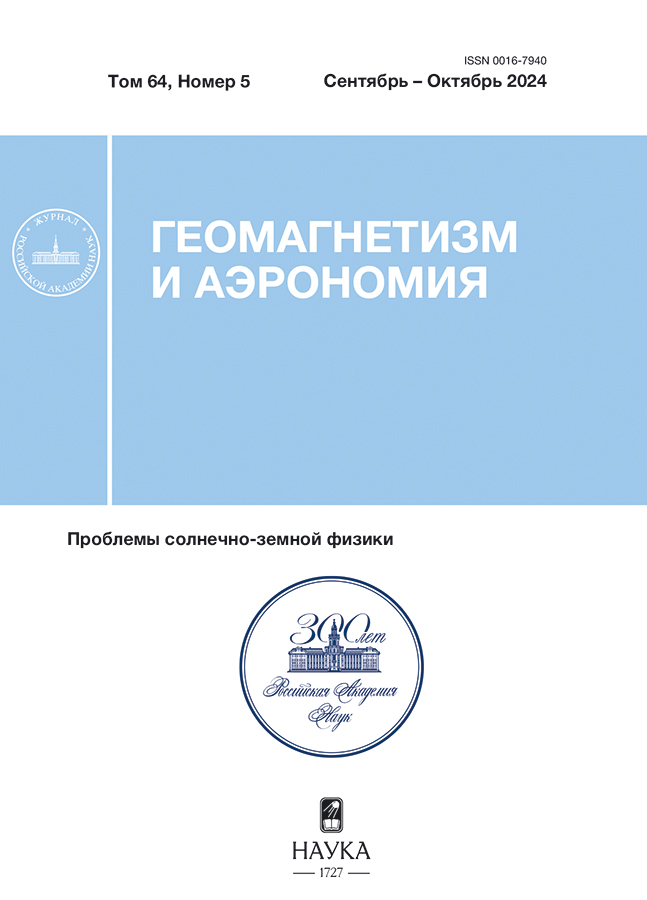Hilbert Transformation and Properties of Solar Cycles in “Envelope−Instantaneous Frequency” Variables
- Авторлар: Shibaev I.G.1
-
Мекемелер:
- Pushkov Institute of Terrestrial Magnetism, Ionosphere and Radio Wave Propagation Russian Academy of Science (IZMIRAN)
- Шығарылым: Том 64, № 5 (2024)
- Беттер: 717-722
- Бөлім: ДИСКУССИИ
- URL: https://kazanmedjournal.ru/0016-7940/article/view/686202
- DOI: https://doi.org/10.31857/S0016794024050116
- EDN: https://elibrary.ru/QPXAIS
- ID: 686202
Дәйексөз келтіру
Аннотация
During analyzing a narrowband signal, the Hilbert transform is often used, which makes it possible to describe the process through slowly changing functions: the envelope (amplitude) and, weakly dependent on time, the characteristic frequency of the signal - the “instantaneous” frequency. Based on the smoothness of these characteristics, one can evaluate the process and compare it at different periods. This approach was used to analyze the spectral components of a series of average monthly Wolf numbers. This description of the main and second harmonics, supplemented by the properties of the long-period component, gives a fairly complete picture of the entire series of monthly averages. The work examines the correspondence of the characteristics of reliable data, with this approach, to the accepted description through the parameters of cycles (maximum of the cycle, duration of the cycle and its growth branches) and constructs an “envelope” of the maxima of the cycles. The time dynamics of the “instantaneous” frequencies of the fundamental and second harmonics of the entire series are also presented and significant differences in their behavior are noted in the intervals corresponding to the reconstructed and reliable parts.
Негізгі сөздер
Толық мәтін
Авторлар туралы
I. Shibaev
Pushkov Institute of Terrestrial Magnetism, Ionosphere and Radio Wave Propagation Russian Academy of Science (IZMIRAN)
Хат алмасуға жауапты Автор.
Email: ishib@izmiran.ru
Ресей, Troitsk, Moscow
Әдебиет тізімі
- Бендат Дж., Пирсол А. Прикладной анализ случайных данных. М.: Мир, 540 с. 1989.
- Витинский Ю.И., Копецкий М., Куклин Г.В. Статистика пятнообразовательной деятельности Солнца. М.: Наука, 296 с. 1986.
- Гоноровский И.С. Радиотехнические цепи и сигналы. М.: Радио и связь, 512 с. 1986.
- Иванов-Холодный Г.С., Чертопруд В.Е. Солнечная активность // Исследование космического пространства. Т. 33. С. 3−99. 1990. (Итоги науки и техники. ВИНИТИ АН СССР)
- Ишков В.Н., Шибаев И.Г. Циклы солнечной активности: общие характеристики и современные границы прогнозирования // Изв. РАН Сер. физ. Т. 70. № 10. С. 1439–1442. 2006.
- Шибаев И.Г. Оценка восстановленной части ряда чисел Вольфа и возможность её коррекции // Астрономический вестн. Т. 42. № 1. С. 66−74. 2008.
- Friedli Th.K. Sunspot Observations of Rudolf Wolf from 1849 – 1893 // Solar Physics. V. 291. № 9-10. P. 2505–2517. 2016. https://doi.org/10.1007/s11207-016-0907-0
- Hathaway D.H. The Solar Cycle // Living Rev. Solar Phys. V. 12. № 4. 2015. https://doi.org/10.1007/lrsp-2015-4.
- Shibaev I., Ishkov V. Investigation of the statistical characteristics of Wolf numbers reliable series: Signs of solar cycles likelihood // Proceedings of Seventh Scientific Conference with International Participation SES 2011, Sofia, Bulgaria, 29 November – 01 December 2011. p. 297−301. 2012.
- Shirahate S. Intraclass rank tests for independence // Biometrika. V. 68. № 2. P. 451− 456. 1981.
- Solar-Terrestrial Influences on Weather and Climate // Proceeding of a Symposium. The Ohio State University, Columbus, Ohio, 24−28 August 1978. Dordrecht, Holland. 348 p. 1979.
- Usoskin I.G., Mursula K., Kovaltsov G.A. The lost sunspot cycle: Reanalysis of sunspot statistics // Astron. Astrophys. V. 403. № 2. P. 743–748. 2003.
Қосымша файлдар













